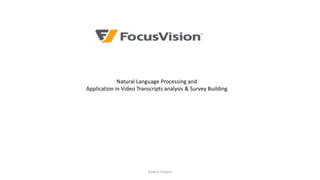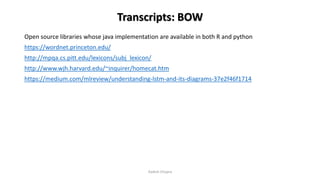Focus vision
- 1. Aadish Chopra Natural Language Processing and Application in Video Transcripts analysis & Survey Building
- 2. Video Transcripts There can be various ways in which Healthcare transcripts can be transcribed. Aadish Chopra Doctor: How are you ? (Smiles) Doctor: How are you ? Doctor: Hwwrru ?
- 3. Transcripts: tf-idf Exploratory analysis via term frequency â inverse document frequency ïThrough this we can know what each transcripts are talking about ïWord frequency vectors can be formed Aadish Chopra
- 4. Transcripts: Bag of Words Two approaches can be followed: ï§ Word â frequency ï§ Manual ï§ Open source libraries Aadish Chopra Merits âĒ Computation is less expensive Demerits âĒ Poor in situations where context is meaningful
- 6. Transcripts: BOW Open source libraries whose java implementation are available in both R and python https://wordnet.princeton.edu/ http://mpqa.cs.pitt.edu/lexicons/subj_lexicon/ http://www.wjh.harvard.edu/~inquirer/homecat.htm https://medium.com/mlreview/understanding-lstm-and-its-diagrams-37e2f46f1714 Aadish Chopra
- 7. Example of Bag of Words A look into the bag of words approach Aadish Chopra Type Len word Stemmed Pos priorpolarity Strongsubject 1 acrimoniously N Anypos negative Weaksubject 1 Active N adj Positive Strongsubject 1 Acumen N Noun Positive Strongsubject 1 Adamant N Adj Negative Weaksubject 1 admission N Noun positive
- 8. Word2vec and LSTM Word2vec approach is particularly useful to understand the meaning of words. This technique uses context words around the center word. LSTM technique is resource intensive and needs a GPU, since the essential elements are memory networks and recursive neural networks Aadish Chopra
- 9. Video Transcripts What can we find out ? âĒ Emotions : We can suggest users what kind of video it is. If we know a userâs preferences, then using the cosine similarity technique we can recommend user what type of content a video has âĒ Comedy, romance, action âĒ Context : We can tell what a video is about âĒ Advertisement insertion points : Googleâs biggest announcement was that advertisers will soon be able to target viewers based on their Google search history, in addition to their viewing behaviors which YouTube was already targeting. âĒ We can infer from Healthcare videos how the interaction is between a patient and a doctor âĒ Unusual events such as if we merge two ads in a video can easily be inferred Aadish Chopra
- 10. Aadish Chopra
- 11. Survey Problem Statement : Focus vision has fixed number of question types for a survey. Let us suppose a customer John comes for the first time from a Healthcare category. After the user builds the survey we can create few more questions in that category with the help of customer John We can recommend questions based on the similarity using the word vectors Or if we know the category of survey we can suggest our own custom template For example question can be in any of the following categories Healthcare Market Research question Greetings Aadish Chopra
- 12. Recommendation Engine We will first build a repository and then using the userâs interaction parameters will evolve our model. So the model might suffer from cold start problems Aadish Chopra
- 13. Aadish Chopra














